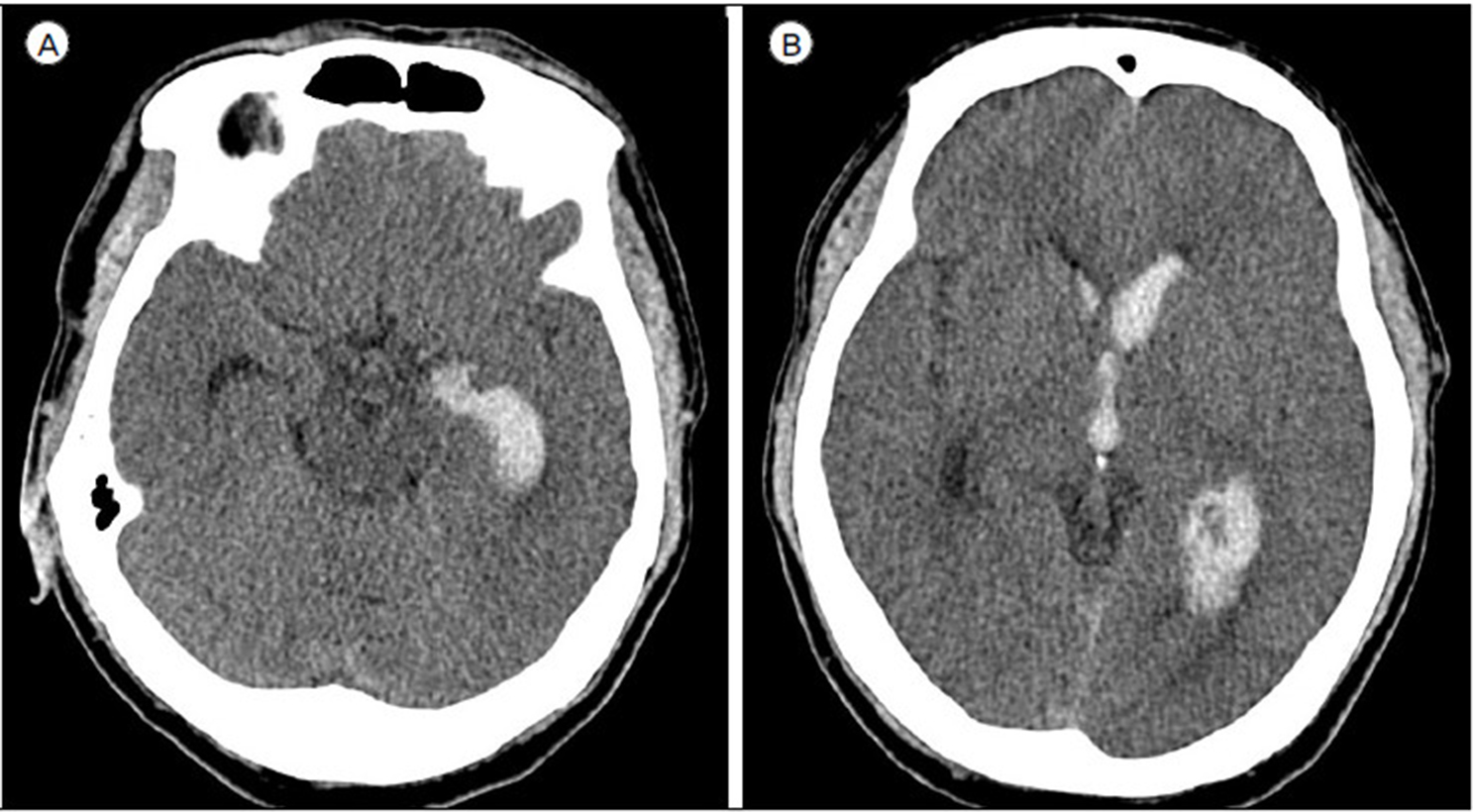J Cerebrovasc Endovasc Neurosurg.
2019 Mar;21(1):18-23. 10.7461/jcen.2019.21.1.18.
Solitary intraventricular hemorrhage without subarachnoid hemorrhage due to aneurysmal rupture: a case report
- Affiliations
-
- 1Department of Neurosurgery, Gyeongsang National University School of Medicine and Gyeongsang National University Changwon Hospital, Changwon, South Korea. 1coo3004@naver.com
- 2Department of Neurosurgery, Seoul National University Bundang Hospital, Seongnam-si, South Korea.
- 3Department of Neurosurgery Gyeongsang National University School of Medicine and Gyeongsang National University Hospital, Jinju, South Korea.
- 4Department of Radiology, Gyeongsang National University School of Medicine and Gyeongsang National University Changwon Hospital, Changwon, South Korea.
- 5Department of Neurology, Gyeongsang National University School of Medicine and Gyeongsang National University Changwon Hospital, Changwon, South Korea.
- KMID: 2465011
- DOI: http://doi.org/10.7461/jcen.2019.21.1.18
Abstract
- The presence of primary intraventricular hemorrhage (IVH) without vascular lesion is very rare. We experienced solitary IVH without subarachnoid hemorrhage due to aneurysmal rupture in a 58-year-old man treated with coil embolization, which contributed to his good prognosis. After 33 days of hospitalization, he had mild right hemiplegic symptoms remaining, and he was transferred to a rehabilitation institute for further treatment. In cases of primary IVH, computed tomography angiography seems worthwhile for making a differential diagnosis, although the possibility of IVH due to cerebral aneurysmal rupture is very low. Endovascular intervention is a good option for diagnosis and treatment.
Keyword
MeSH Terms
Figure
Reference
-
1. Anagnostopoulos C, Chamilos C, Hadjigeorgiou G, Petsanas A. Isolated massive intraventricular haemorrhage without subarachnoid haemorrhage due to rupture of a posterior communicating artery aneurysm. Br J Neurosurg. 2017; 04. 1–2.
Article2. Angelopoulos M, Gupta SR, Kia BA. Primary intraventricular hemorrhage in adults: clinical features, risk factors, and outcome. Surg Neurol. 1995; 05. 44(5):433–436. discussion 437.
Article3. Darby D, Donnan G, Saling M, Walsh K, Bladin P. Primary intraventricular hemorrhage: clinical and neuropsychological findings in a prospective stroke series. Neurology. 1988; 01. 38(1):68–75.
Article4. Flint AC, Roebken A, Singh V. Primary intraventricular hemorrhage: yield of diagnostic angiography and clinical outcome. Neurocrit Care. 2008; 03. 8(3):330–336.
Article5. Gates PC, Barnett HJM, Vinters HV, Simonsen RL, Siu K. Primary intraventricular hemorrhage in adults. Stroke. 1986; 02. 17(5):872–877.
Article6. Inagawa T, Matsuda Y, Kamiya K, Aoyama H, Nagasako R, Yamamoto M. Saccular aneurysm of the distal anterior choroidal artery--case report. Neurol Med Chir (Tokyo). 1990; 03. 30(7):498–502.7. Jayakumar PN, Taly AB, Bhavani UR, Arya BYT, Nagaraja D. Prognosis in solitary intraventricular haemorrhage. Clinical and computed tomographic observations. Acta Neurol Scand. 1989; 07. 80(1):1–5.8. Knuckey NW, Epstein MH, Haas R, Sparadeo F. Distal anterior choroidal artery aneurysm: intraoperative localization and treatment. Neurosurgery. 1988; 06. 22(6 Pt 1):1084–1087.
Article9. Konishi Y, Kadowaki C, Hara M, Takeuchi K. Aneurysms associated with moyamoya disease. Neurosurgery. 1985; 16(4):484–491.
Article10. Martí-Fàbregas J, Piles S, Guardia E, Martí-Vilalta JL. Spontaneous primary intraventricular hemorrhage: clinical data, etiology and outcome. J Neurol. 1999; 04. 246(4):287–291.
Article11. Nakagawa K, Lee SB. Predominant intraventricular hemorrhage from a ruptured posterior communicating artery aneurysm. Neurohospitalist. 2014; 10. 4(3):164.
Article12. Nishihara J, Kumon Y, Matsuo Y, Sakaki S. A case of distal anterior choroidal artery aneurysm: case report and review of the literature. Neurosurgery. 1993; 05. 32(5):834–837. discussion 837.13. Papo I, Salvolini U, Caruselli G. Aneurysm of the anterior choroidal artery with intraventricular hematoma and hydrocephalus. Case report. J Neurosurg. 1973; 08. 39(2):255–260.14. Ragland RL, Gelber ND, Wilkinson HA, Knorr JR, Tran AA. Anterior communicating artery aneurysm rupture: an unusual cause of acute subdural hemorrhage. Surg Neurol. 1993; 40(5):400–402.
Article15. Ranjan A, Joseph T. Giant aneurysm of anterior ethmoidal artery presenting with intracranial hemorrhage. Case report. J Neurosurg. 1994; 12. 81(6):934–936.16. Roos YB, Hasan D, Vermeulen M. Outcome in patients with large intraventricular haemorrhages: a volumetric study. J Neurol Neurosurg Psychiatry. 1995; 05. 58(5):622–624.
Article17. Rosenorn J, Westergaard L, Hansen PH. Mannitol-induced rebleeding from intracranial aneurysm. Case report. J Neurosurg. 1983; 09. 59(3):529–530.18. Sandin JA, Salamat MS, Baskaya M, Dempsey RJ. Intracerebral hemorrhage caused by the rupture of a nontraumatic middle meningeal artery aneurysm. Case report and review of the literature. J Neurosurg. 1999; 05. 90(5):951–954.19. Tanaka Y, Ogashiwa M, Takeuchi K. Moyamoya phenomenon with accompanying intracranial aneurysm. Neuroradiology. 1978; 12. 16(1):289–290.20. Tembl J, Lago A, Baquero M, Blasco R. Primary intraventricular hemorrhage: an analysis of eight cases. Rev Neurol. 1997; 25(138):215–218.21. Venti M. Subarachnoid and intraventricular hemorrhage. Front Neurol Neurosci. 2012; 30:149–153.
Article22. Voldby B, Enevoldsen EM. Intracranial pressure changes following aneurysm rupture. Part 3: Recurrent hemorrhage. J Neurosurg. 1982; 06. 56(6):784–789.23. Weinstein R, Ess K, Sirdar B, Song S, Cutting S. Primary Intraventricular Hemorrhage: Clinical Characteristics and Outcomes. J Stroke Cerebrovasc Dis. 2017; 05. 26(5):995–999.
Article24. Weisberg LA. Computerized tomography in intracranial hemorrhage. Arch Neurol. 1979; 07. 36(7):422–426.
Article25. Yeung R, Ahmad T, Aviv RI, de Tilly LN, Fox AJ, Symons SP. Comparison of CTA to DSA in determining the etiology of spontaneous ICH. Can J Neurol Sci. 2009; 03. 36(2):176–180.
Article26. Yoneoka Y, Ezuka I, Takai N, Oda T, Tamura T, Yamashita S. Ruptured distal anterior choroidal artery aneurysm presenting with casting intraventricular haemorrhage. Acta Neurochir (Wien). 1998; 02. 140(2):185–189.
Article
- Full Text Links
- Actions
-
Cited
- CITED
-
- Close
- Share
- Similar articles
-
- Simultaneous Occurrence of Aneurysmal Subarachnoid Hemorrhage and Hypertensive Intracerebral Hemorrhage
- Clinical Analysis of Subarachnoid Hemorrhage with Intraventricular Hemorrhage due to Aneurysmal Rupture
- Evaluation of Subarachnoid Hemorrhage due to Aneurysmal Rupture and Cerebral Vasospasm by CT
- Delayed Rupture of Traumatic Intracranial Aneurysm Developed by Minor Head Trauma
- A Case of Intraventricular Meningioma Acompanied by Intraventricular Hematoma and Subarachnoid Hemorrhage: Case Report





